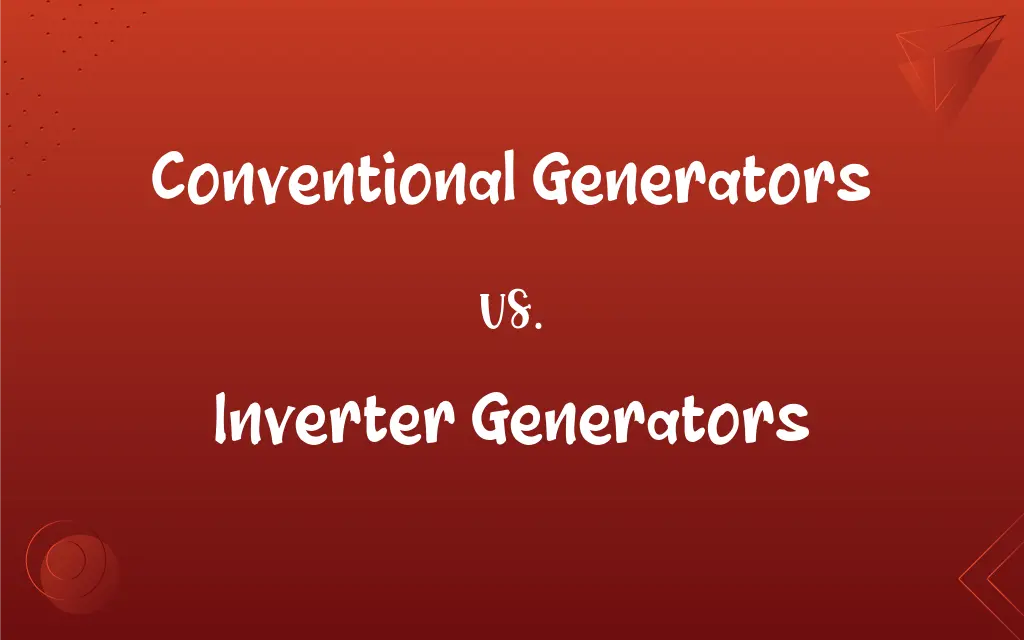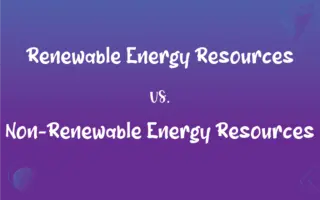Conventional Generators vs. Inverter Generators: What's the Difference?
Edited by Aimie Carlson || By Harlon Moss || Updated on October 16, 2023
Conventional generators produce AC power, are larger, and noisier, while inverter generators convert AC to DC then back to AC, are compact, and quieter.

Key Differences
Conventional generators, known for their straightforward mechanism, generate alternating current (AC) directly from the engine. This process contrasts with inverter generators, which utilize a rectifier to convert AC to direct current (DC) and then invert it back to a stable AC output.
Size and portability are significant differentiators; conventional generators are typically larger and heavier, making them less portable than the compact and lightweight design of inverter generators, which are designed for easy transportation.
When it comes to noise levels, conventional generators tend to operate louder due to their direct power production method and larger engines. Inverter generators, in contrast, are known for their quiet operation, making them suitable for varied settings, especially where noise is a concern.
Fuel efficiency is another crucial difference. Conventional generators run at a constant speed, often leading to higher fuel consumption. Inverter generators, however, adjust their engine speed to the load demand, resulting in better fuel efficiency and longer run times.
Lastly, the power output quality differs significantly. Conventional generators might experience power fluctuations, leading to "dirty" energy that can harm sensitive electronics. Inverter generators provide "clean," stable energy, safe for devices like smartphones and computers.
ADVERTISEMENT
Comparison Chart
Power Conversion
Produce AC power directly
Convert AC to DC, then back to AC
Size/Portability
Larger, less portable
Compact, more portable
Noise Level
Typically louder
Generally quieter
Fuel Efficiency
Run at constant speed, less efficient
Adjust speed based on load, more efficient
Power Quality
Can produce power fluctuations
Provide stable, high-quality power
ADVERTISEMENT
Conventional Generators and Inverter Generators Definitions
Conventional Generators
Typically bulkier and louder in operation, suitable for industrial uses.
During the power outage, conventional generators kept the factory running.
Inverter Generators
They have variable engine speeds, adjusting to the required load and saving fuel.
The inverter generators proved cost-effective for the outdoor concert, adjusting to the energy needs.
Conventional Generators
Known for their high-power output and utility in sustained, heavy-duty applications.
The construction site operated multiple large conventional generators.
Inverter Generators
Produce "clean" electricity, safe for sensitive electronic devices.
He relied on inverter generators to power his sensitive laboratory equipment during field research.
Conventional Generators
They operate on a motor that runs at a consistent speed to generate electricity.
The fairgrounds were illuminated by several roaring conventional generators.
Inverter Generators
Compact and portable, ideal for recreational activities, home use, or small businesses.
Many homeowners purchased inverter generators for emergency backup power that didn't disrupt the neighborhood.
Conventional Generators
Produce direct power but can experience fluctuations affecting sensitive electronics.
They didn't use conventional generators for the computers due to potential power surges.
Inverter Generators
Innovative devices that produce consistent and efficient electrical output.
Campers prefer using inverter generators due to their quiet operation.
Conventional Generators
Devices that convert mechanical energy into electrical energy as alternating current.
They used conventional generators to restore power after the storm.
Inverter Generators
Known for converting AC to DC power, then inverting it back to cleaner AC power.
The event organizers chose inverter generators to protect the musical equipment.
FAQs
What makes inverter generators different?
Inverter generators convert AC to DC and then back to AC for cleaner, more stable electricity.
What are conventional generators?
Conventional generators are units that convert mechanical energy into alternating current (AC) electricity directly.
Can inverter generators save fuel?
Yes, they adjust engine speed to power demand, enhancing fuel efficiency.
Do conventional generators make a lot of noise?
Generally, yes, they're louder than inverter generators.
Are inverter generators suitable for sensitive electronics?
Absolutely, they provide consistent, stable power without surges.
Are inverter generators easy to transport?
Yes, they're known for their lightweight and compact design.
What's the lifespan of conventional generators?
With proper maintenance, they can last for many years.
Do conventional generators need regular maintenance?
Yes, like all machinery, they require regular maintenance for optimal performance.
What fuel do conventional generators use?
Most use gasoline, diesel, or propane.
How long can a conventional generator run?
With enough fuel, they can run continuously for several hours.
Can I link two inverter generators together?
Yes, certain models can be paralleled to increase power output.
How powerful are conventional generators?
They can produce a significant amount of power, suitable for high-demand applications.
How do inverter generators handle varying loads?
They adjust their engine speed to match the load, maintaining efficient operation.
Why are inverter generators more expensive?
Their advanced technology and fuel efficiency features account for the higher cost.
Are conventional generators better for industrial use?
Generally, yes, due to their higher power output.
Are conventional generators portable?
They can be, but they're generally heavier and bulkier compared to inverter generators.
Can conventional generators power my entire house?
Depending on their capacity, many can power a household during outages.
Can I use an inverter generator for camping?
Yes, their quiet operation and portability make them ideal for camping.
Do inverter generators produce clean energy?
Yes, they produce electricity with less fluctuation, safe for sensitive devices.
Are inverter generators environmentally friendly?
They tend to produce fewer emissions and use less fuel than conventional types.
About Author
Written by
Harlon MossHarlon is a seasoned quality moderator and accomplished content writer for Difference Wiki. An alumnus of the prestigious University of California, he earned his degree in Computer Science. Leveraging his academic background, Harlon brings a meticulous and informed perspective to his work, ensuring content accuracy and excellence.
Edited by
Aimie CarlsonAimie Carlson, holding a master's degree in English literature, is a fervent English language enthusiast. She lends her writing talents to Difference Wiki, a prominent website that specializes in comparisons, offering readers insightful analyses that both captivate and inform.
































































